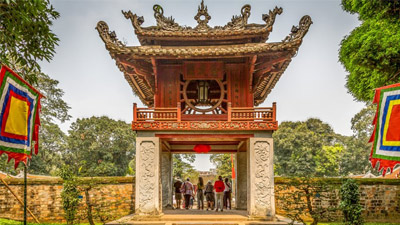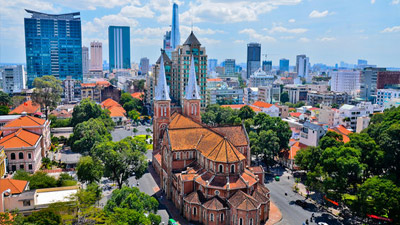Ca Tru Singing
 "Ca tru" singing is an old form of singing in the North of Vietnam that originated and flourished in around 15th century. In different regions, "ca tru" singing has different names such as "A dao" singing, "co dau" singing, "nha tro" singing, etc. "Ca tru" singing itself originally used to be a form of entertainment for royal court, wealthy people and scholars in feudal era.
"Ca tru" singing is an old form of singing in the North of Vietnam that originated and flourished in around 15th century. In different regions, "ca tru" singing has different names such as "A dao" singing, "co dau" singing, "nha tro" singing, etc. "Ca tru" singing itself originally used to be a form of entertainment for royal court, wealthy people and scholars in feudal era.
That form of performance is a fantastic blend of poems, singing and traditional instruments (including castanets, “dan day” and “chau” drum). Castanets (so-called “phach” in Vietnamese) are a couple of small wooden sticks and a piece of bamboo to beat the sticks on. “Dan day” is a unique traditional instrument of Vietnam. Its structure is quite similar to guitar, but has 3 strings and wooden trapezoidal body. “Chau” drum has an ordinary appearance. But the special feature of “chau” drum is drumstick because the instrumentalist uses only one drumstick to play that drum.
A band of “ca tru” singing consists of three people: a female vocalist (normally called “dao” or “ca nuong” in Vietnamese), a male instrumentalist (“kep”) and a male musician (called “quan vien” in Vietnamese). The singer sings the song of the musician and plays castanets at for the beat. The instrumentalist assists her by playing “dan day”. The musician (usually the composer of the song performed) also sits together and beat “chau” drum to express his feeling to the performance. If he beats “chau” drum once, it means “praise”. If he beats the drum twice, this act means “disapproval”. Three of them wear Vietnamese traditional “ao dai” during the performance.
Since 20th century, “ca tru” singing has been at risk of disappearance. On October 1st, 2009, “ca tru” singing was officially recognized as an Intangible Cultural Heritage by UNESCO. At present, there are 63 “ca tru” singing clubs in 14 provinces (or cities) in Vietnam.

Vietnam Cai Luong
Cai Luong is a type of performance coming from the South Vietnam and formed from the traditional music of the Mekong River Delta.

Chau Van Singing
"Chau Van" (or "van" singing) is an ancient form of art performance that is featured with religious color. It originated in the Red River Delta of Northern Vietnam in around 16th century and widely...

Cheo Singing
"Cheo" is a traditional form as well as a typical representative of Vietnamese opera beside "Tuong" and "Cai Luong". "Cheo" is a form of art performance that is very popular in the North of Vietnam,...

Then Singing
"Then" singing is a traditional kind of oratorio art in Vietnam. That form of art performance originated form religious activities of Tai, Tay and Nung ethnic groups in Northern Vietnam. The name...

Hue's Royal Court Music
Hue's royal court music is called "Nha Nhac Cung Dinh" (Royal court's refined music) in Vietnamese. It's an old form of art performance that used to official music of royal court for centuries. For a...

Quan Ho Singing
"Quan Ho" singing is a typical form of Vietnamese folk music that originated in Bac Ninh Province, Vietnam. Over 300 years of existence, that form of art performance has become an essential part of...
Vietnam Travel Guide
- Vietnam Overview
- Vietnam Geography
- Vietnam History
- Vietnam Ecology And Environment
- Vietnam Government And Politics
- Vietnam Economy
- Vietnam Demographics
- Vietnam Customs
- Vietnam Art Performance
- Vietnam Religions
- Vietnam Festivals
- Vietnam Gastronomy
- Get To Vietnam
- Vietnam Travel Tips
- Vietnam Travel Articles & News

 BEST TOURS
BEST TOURS



